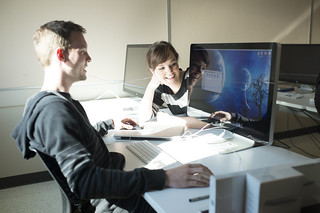Getting started with blended learning
What is “blended learning”?
 “Blended learning” is an umbrella term, referring to learning activity that happens across contexts. The ‘blend’ is usually between learning activity happening inside and outside the classroom, or between learning that happens in real-world and online environments (or both!). Many of us learn in this way every day, informally – we might look up information in books and online, discuss it with peers over coffee and via email, draft new ideas on paper and on the laptop. As technology becomes ubiquitous, we need to be able to take advantage of both physical and virtual learning opportunities, to recognise the strengths and weaknesses of each, and to synthesise learning from different contexts. The challenge for educators is to design the right ‘blend’ of activity – both to support specific learning, and to help students to develop their independent learning skills for the future.
“Blended learning” is an umbrella term, referring to learning activity that happens across contexts. The ‘blend’ is usually between learning activity happening inside and outside the classroom, or between learning that happens in real-world and online environments (or both!). Many of us learn in this way every day, informally – we might look up information in books and online, discuss it with peers over coffee and via email, draft new ideas on paper and on the laptop. As technology becomes ubiquitous, we need to be able to take advantage of both physical and virtual learning opportunities, to recognise the strengths and weaknesses of each, and to synthesise learning from different contexts. The challenge for educators is to design the right ‘blend’ of activity – both to support specific learning, and to help students to develop their independent learning skills for the future.
There are two key principles to remember if you’re new to blended learning. The first is to start with the right task for the learning, and then find the right tool (don’t choose a tool and then try to find a use for it!).
The second principle is the ‘blending’ part. The idea of this is that one type of learning activity supports and feeds into the other, and connections and transferability are clear.
Getting started with blended learning
You can ‘blend’ almost any kind of teaching, by starting to add in activities that help students bridge the learning they are doing inside and outside taught sessions. There is no ‘one size fits all’ approach, because each learning activity will depend on what you want to achieve. Starting small, with one type of activity or tool, can help you and your students build confidence and skills, and figure out what works well and what doesn’t. Here are some tips for designing learning activities online:
- Identify learning that can be done outside class time. Sometimes the best way to do this is to think about what you would really like to be able to do with your students in the classroom, and work backwards. Storyboarding can help with this.
- Design the right activity to support the learning. What should the student be doing in order to learn this? Who else should be involved? What resources will they need? Prompts like the Hybrid Learning Model cards can help you to frame different kinds of learning activities.
- Once you have a clear idea of what you want to happen, then choose the right tool to support this type of activity. The University provides a core set of tools that we have vetted for you. Beyond this there are hundreds of possibilities! All of these have strengths and weaknesses, but don’t worry, you don’t need to be a tech guru. The Learning Technology team can help with this.
 Many people begin by transferring a learning activity that they already know works well into the online environment. For example, if you would usually ask your students to discuss a contentious idea, or defend a position in a debate, you could do this in an online forum, or if you would usually demonstrate something for the students, you could do this using video. If you’re a little more confident, you might want to think of some ways that technology can extend your teaching and allow you to do things that you couldn’t do in a traditional face to face setting. You might use it to connect students to resources, peers or external experts. You might use it to provide visualisations of text-based materials, or to build knowledge checks that provide students with instant feedback, or to create spaces where they can pool their own resources and ideas to inform their work.
Many people begin by transferring a learning activity that they already know works well into the online environment. For example, if you would usually ask your students to discuss a contentious idea, or defend a position in a debate, you could do this in an online forum, or if you would usually demonstrate something for the students, you could do this using video. If you’re a little more confident, you might want to think of some ways that technology can extend your teaching and allow you to do things that you couldn’t do in a traditional face to face setting. You might use it to connect students to resources, peers or external experts. You might use it to provide visualisations of text-based materials, or to build knowledge checks that provide students with instant feedback, or to create spaces where they can pool their own resources and ideas to inform their work.
Tips for success
Be clear about the why and the how. Sometimes staff who try blended learning for the first time find that students don’t engage as they had hoped with the online activity. Student feedback tells us this is usually because either they don’t understand it, or they don’t see the value. When introducing online tasks, it helps to make it clear why they are being used, and how they will help students to achieve the learning outcomes. It’s also a good idea to explain any unfamiliar tools or processes in advance, just as you would when introducing a new task in the classroom. If you can, get a student perspective on your design before you launch it – and maybe try some online courses yourself, to see what it’s like on the other side!
Be realistic. Be aware that creating online resources and supporting online activity might require slightly different skills to the ones you use in the classroom, so allow yourself time to develop these. Think too about the ratio of effort to impact for your module – creating complex professional-looking resources requires a big investment of time in advance, although this may be worth it if there is one sticky concept that students really struggle with early in their studies. On the other hand, you may be able to get the same effect by using existing resources on that topic and asking students to critique them, or even by asking students to research the topic and share their own key resources. You don’t need to be a computer genius (or spend months learning complex software) to create that lightbulb moment!
Learn from others. Working in a team can really help here – not just in terms of sharing the workload and learning new skills, but also in setting consistent expectations for students across different modules on the same programme. If you’re stuck for ideas, have a look of some of our case studies, or ask around to see what colleagues are trying.
Do one thing
Ready to give it a try? If you want help figuring out what to blend, at a session, module or even programme level, the Learning Design team can help. If you already have an idea for an online activity, but you’re not sure about the technology, the Learning Technology team can help. Get in touch and we’ll help you get started!
Recent Posts
- Blackboard Upgrade – November 2025
- Fix Your Content Day 2025
- Blackboard Upgrade – October 2025
- Blackboard Upgrade – September 2025
- The potential student benefits of staying engaged with learning and teaching material
- LearnTech Symposium 2025
- Blackboard Upgrade – August 2025
- H5P (HTML5 package) content types meets the needs of Jim Atkinson, Staff Development Trainer
- Blackboard Upgrade – July 2025
- StudySmart 2 – Student Posters
Tags
ABL Practitioner Stories Academic Skills Accessibility Active Blended Learning (ABL) ADE AI Artificial Intelligence Assessment Design Assessment Tools Blackboard Blackboard Learn Blackboard Upgrade Blended Learning Blogs CAIeRO Collaborate Collaboration Distance Learning Feedback FHES Flipped Learning iNorthampton iPad Kaltura Learner Experience MALT Mobile Newsletter NILE NILE Ultra Outside the box Panopto Presentations Quality Reflection SHED Submitting and Grading Electronically (SaGE) Turnitin Ultra Ultra Upgrade Update Updates Video Waterside XerteArchives
Site Admin

